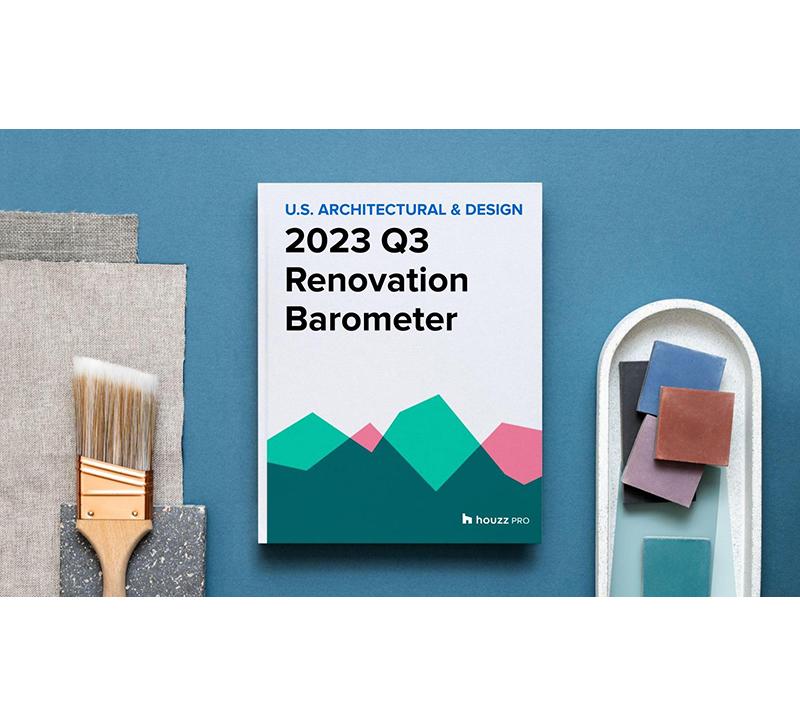Houzz Inc. has released the Q3 2023 Houzz U.S. Renovation Barometer. The Barometer tracks residential renovation market expectations, project backlogs and recent activity among businesses in the U.S. construction sector and the architectural and design services sector. Fielded from June 22 through July 1, 2023, the Barometer provides timely insights into the impact of recent economic volatility on the home improvement market. Slightly more professionals across sectors anticipate business growth rather than declines in the third quarter of 2023, following slowed activity and homeowner requests to postpone or reduce the scope of their projects in the first half of the year.
“Pent-up demand and macroeconomic conditions, such as aging housing stock and high mortgage rates, which continue to drive home improvement activity, are instilling a sense of optimism among builders, remodelers, architects and interior designers as they look ahead to the second half of the year,” said Marine Sargsyan, Houzz staff economist. “We continue to monitor the industry to identify whether improvements to inflation and other economic indicators create more stable pricing for businesses and an environment in which homeowners proceed with their full project scope. That said, ongoing labor shortages and product and material delays will continue.”
Backlogs have lengthened across the construction sector to a record high of 13 weeks, up 2.5 weeks compared to the same period last year. In fact, construction businesses in the New England region report wait times of 21.8 weeks before they can begin work on a new midsize project. Business in the architectural and design services sector report backlogs of 6.4 weeks.
Q3 2023 Construction Sector Barometer
In the construction industry, both build-only and design-build professionals have a favorable outlook on anticipated business performance. Build-only remodelers anticipate an increase in business activity in Q3 (54 compared to 50 in Q2), while expectations among design-build firms remains the same for Q3 at 53. This follows an uptick in both project inquiries and new projects for both groups (from 51 in Q2 to 54 in Q3 and 52 in Q2 to 53 in Q3, respectively).
The Expected Business Activity Indicator related to project inquiries and new committed projects increased to 54 for Q3 (compared with 51 in Q2), which indicates that more businesses expect quarter-over-quarter increases than quarter-over-quarter decreases. Expectations for project inquiries increased to 54, compared with 51 in Q2, and new committed projects are at 53, up 1 point relative to expectations in Q2 (52).
The Project Backlog Indicator is 13 weeks in the beginning of Q3, which is 2.5 weeks longer than a year ago and more than double pre-pandemic levels in Q3 2019. This increase is primarily driven by wait times reported by businesses in the New England division.
The Recent Business Activity Indicator related to project inquiries and new committed projects declined to 43 in Q2, down 2 points from Q1. This is driven by a 4-point decline in project inquiries in Q2, relative to the previous quarter. New committed projects remained steady at 47 in Q2.
Q3 2023 Architectural and Design Services Sector Barometer
More firms in the architectural and design services sector reported increases in their business expectations for Q3 than reported decreases, although both subsectors reflect a decline in business performance expectations compared to the previous quarter (from 55 in Q2 to 52 in Q3 and 57 in Q2 to 52 in Q3, respectively). This follows a 3-point decrease in project inquiries (from 55 in Q2) and a 6-point decrease in new projects (from 58 in Q2).
The Expected Business Activity Indicator related to project inquiries and new committed projects decreased to 52 in Q3 (down 4 points from Q2). The decline in the overall indicator is primarily driven by a 6-point drop in expectations for new committed projects to 52 in Q3. Expectations for project inquiries are down by only 3 points in Q3 (52 compared with 55 in Q2).
The Project Backlog Indicator is 6.4 weeks in the beginning of Q3. Backlogs are 1.1 weeks shorter than they were one year ago.
The Recent Business Activity Indicator related to project inquiries and new committed projects slightly increased to 43 in Q2 (compared with 42 in Q1), with interior designers at 46 versus architects at 41. Following a continuous decline over eight consecutive quarters, the overall indicator is up 1 point at 43 relative to Q2. The recent project inquiries remained steady at 40 and the new committed projects increased to 46 in Q2 (compared with 44 in Q1).
Regional Backlogs
For the construction sector, the New England division (including Connecticut, Maine, Massachusetts, New Hampshire, Rhode Island, and Vermont) has the longest backlog (21.8 weeks) driven by wait times reported by build-only and design-build firms in the region (21.2 and 22.4 weeks, respectively). Businesses in the West South Central division (including Arkansas, Louisiana, Oklahoma, and Texas) report backlogs of 7.9 weeks before they can begin a new project, the shortest wait time reported by construction firms among the nine Census divisions. Compared with the same quarter one year ago, backlogs for the construction sector are longer across eight of nine Census divisions (across all but the West South Central division).
Backlogs also vary across all regional divisions among businesses in the architecture and design services sector. Businesses in the East South Central division (Alabama, Kentucky, Mississippi, and Tennessee) reported backlogs of 9.2 weeks, while the West North Central division (including North Dakota, South Dakota, Nebraska, Kansas, Missouri, Iowa, and Minnesota) showed much shorter backlogs at 2.5 weeks. Backlogs reported by architects in the East South Central division (12.9 weeks) are the driving force for long wait times, whereas the wait to begin a new project with an interior designer in that area is only 3 weeks. Compared with the same quarter one year ago, backlogs for the architectural and design services sector are longer across only two of the nine Census divisions (East South Central and South Atlantic divisions).







